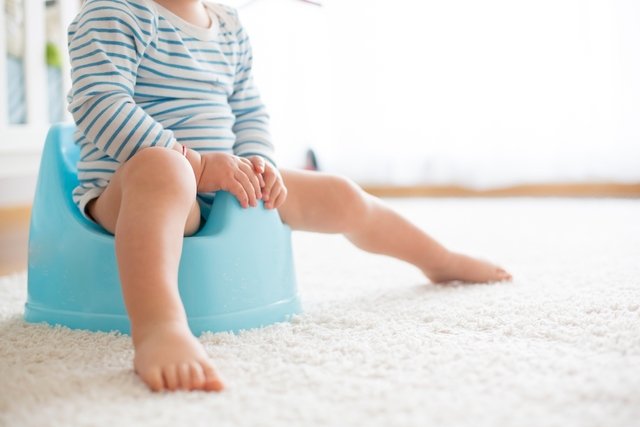According to the Brazilian Society of Pediatrics, the first sign that it is the right time to take off the diaper is when the child begins to say that he has pooped or peed in the diaper. Therefore, from that moment on, parents should observe and note the child’s habits, especially the time of day at which he usually relieves himself, as this will allow him to start potty training.
Until the age of two, the child cannot control the bladder or bowel sphincters, however potty training can begin from the age of 1 and a half, with daytime potty training, which takes at least 6 months. A good way to start daytime potty training is to take off the diaper for a few hours during the day, and gradually leave the child without a diaper throughout the day, observing signs that the baby wants to eliminate and encouraging the use of the bathroom. .
Potty training should be done with guidance from the pediatrician and, in addition, it is important that parents always have patience and understand that each child has their own time, rhythm and habits, and comparisons with other children should be avoided and always encouraged with explanations. , conversations and compliments.

Some tips for potty training your baby are:
1. Taking off the diaper for a few hours a day
To start potty training, it is important to do it gradually for at least 6 months, starting from the age of 2, as advised by the pediatrician, removing the diaper for a few hours during the day, so that the child gradually gets used to not having the diaper on. and so that parents can observe the child’s behavior, understand the signs that the child is going to eliminate and encourage the use of the potty.
Little by little, you can leave the child without the diaper throughout the day, but you must keep the night diaper on initially.
2. Encourage potty use
It is important to encourage the child to use the potty or toilet seat, from the age of two, as advised by the pediatrician, letting them get used to the chosen device. However, initially, the ideal is to use the potty as the child feels more comfortable and safer.
To encourage the use of the potty, you should initially sit the child on the potty with their clothes on and gradually suggest that they sit without their clothes on, so that the child becomes familiar with the potty. It is important to make sure that the child’s feet are placed on the floor in a way that makes them feel comfortable. It is also important to use simple, positive terms that help encourage the child to start using the potty.
Furthermore, the potty should be in the bathroom, close to the toilet to encourage the child to associate needs with the bathroom environment. In some cases, parents may choose to use the toilet reducer, but they must make sure that the child can reach the toilet, using a stool or stepladder, and that they feel safe and not afraid of falling into the toilet.
If the child resists using the potty or toilet seat or does not get the hang of using it within a few weeks, it may indicate that they are not yet ready for potty training, and it is recommended not to force use and wait a few months to try again.
3. Create a routine
To encourage potty training, a routine must be created to help with good habits, such as sitting the child on the potty or toilet seat for a few minutes at regular intervals, after meals, upon waking up or before going to bed, and leaving the child get up when you feel like it.
In addition, you should encourage and praise the child for trying to use the potty or toilet, and remind him that he can try again later.
If you are leaving the house, such as going to school or going on trips with your child, you should take and encourage your child to use the potty before leaving home.
4. Talk to the child
It is important to talk to the child and explain what the potty and toilet are and what they are for, showing how to use them and setting an example, how to relieve themselves in the toilet in front of the child, showing the toilet paper and flushing , so that the child understands and feels motivated to follow their parents’ example.
5. Praise the achievement
Every time the child uses the potty or toilet, whether because of parental encouragement or because the child signaled that they wanted to use it, it is important to praise the achievement and show the parents’ happiness so that the child feels stimulated and motivated to repeat. utilization and achievement.
6. Be patient
During potty training, sometimes the child may leak pee or poop, and it is important that parents have patience and persistence to teach and encourage the child to signal that they want to eliminate or use the potty.
Furthermore, the child’s potty training process takes a long time and you must follow the child’s rhythm, always encouraging the baby to start learning without resisting or associating negatively with the last attempts.
7. Don’t fight with the child
It is important to never fight or swear at your child, so as not to discourage them and make them afraid to try again. Pressure on the child will not make him learn faster, on the contrary, it can generate trauma and delay potty training.
In cases where the baby pees or poops in his underwear or panties, you should speak calmly to the child, explain that he must pee or poop in the bathroom and change the underwear or panties for a new one, in an informative tone. not scolding.
7. Dress the child in light clothes
To facilitate potty training, the child should be dressed in light, easy-to-remove clothing, such as shorts or pants with elastic, making it easier to remove when the child signals that he or she wants to eliminate.
8. Bring extra clothes
During the potty training phase, it is normal for “accidents” to happen, in which the child pees or poops outside the appropriate place or on his own clothes. Therefore, it is important to go out with your child, taking extra clothes to change into, in case accidents happen.
When changing the child’s clothes, you must make them comfortable and not draw their attention to avoid causing trauma.
9. Do nighttime potty training
Nighttime potty training should be done with the pediatrician’s guidance, being one of the last stages of potty training, which is generally recommended when the child has already gone through daytime potty training, and shows some signs that they already have control of their sphincters and are prepared to take potty training. the night diaper, such as waking up normally with a dry diaper, asking to go to the bathroom during the day or feeling uncomfortable putting on the diaper at night, for example.
During night potty training, it is important to talk to the child, explain that they will not sleep in a diaper, and encourage them to call their parents when they want to go to the bathroom at night.
Furthermore, some tips that can help with nighttime potty training are taking the child to the bathroom at night before bed, avoiding giving the child excessive liquids before bed or waking the child up in the early hours of the morning, at least once, and taking him to the bathroom.
10. Use waterproof sheets
For both daytime and nighttime potty training, it is important to have waterproof sheets, to prevent the mattress, sofa or rugs, or other surfaces that the baby uses from becoming dirty or wet if an “accident” happens.
11. Understand that relapses happen
Sometimes, during potty training, it is common for the child to relapse and go back to using diapers, it is important that parents do not get discouraged and encourage the child, understanding that each child has their own time and may not be ready for potty training at that time. .
If this happens, you should wait 4 to 6 weeks and try again, always maintaining a positive feeling so that the baby does not feel punished or unmotivated.

Sign up for our newsletter and stay up to date with exclusive news
that can transform your routine!
Warning: Undefined array key "title" in /home/storelat/public_html/wp-content/plugins/link-whisper-premium/templates/frontend/related-posts.php on line 12
Warning: Undefined array key "title_tag" in /home/storelat/public_html/wp-content/plugins/link-whisper-premium/templates/frontend/related-posts.php on line 13




